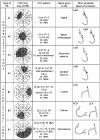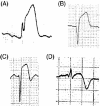Updated electrocardiographic classification of acute coronary syndromes
- PMID: 24827799
- PMCID: PMC4040874
- DOI: 10.2174/1573403x10666140514102754
Updated electrocardiographic classification of acute coronary syndromes
Abstract
The electrocardiogram (ECG) findings in acute coronary syndrome should always be interpreted in the context of the clinical findings and symptoms of the patient, when these data are available. It is important to acknowledge the dynamic nature of ECG changes in acute coronary syndrome. The ECG pattern changes over time and may be different if recorded when the patient is symptomatic or after symptoms have resolved. Temporal changes are most striking in cases of ST-elevation myocardial infarction. With the emerging concept of acute reperfusion therapy, the concept ST-elevation/ non-ST elevation has replaced the traditional division into Q-wave/non-Q wave in the classification of acute coronary syndrome in the acute phase.
Keypoints: In acute coronary syndrome, in addition to the traditional electrocardiographic risk markers, such as ST depression, the 12-lead ECG contains additional, important diagnostic and prognostic information. Clinical guidelines need to acknowledge certain high-risk ECG patterns to improve patient care.
Figures






References
-
- Thygesen K, Alpert JS, Jaffe AS, Simoons ML, Chaitman BR, White HD. Third universal definition of myocardial infarction. J Am Coll Cardiol. 2012;60:1581–98. - PubMed
-
- Nikus K, Pahlm O, Wagner G , et al. Electrocardiographic classification of acute coronary syndromes: A review by a committee of the International Society for Holter and Non-invasive Electrocardiology. J Electrocardiol. 2010;43:91–103. - PubMed
-
- Blackburn H, Keys A, Simonson E, Rautaharju P, Punsar S. The electrocardiogram in population studies.A classification system. . Circulatio. 1960;21:1160–75. - PubMed
-
- Selvester RH, Wagner GS, Hindman NB. The Selvester QRS scoring system for estimating myocardial infarct size.the development and application of the system. Arch Intern Med. 1985;145:1877–81. - PubMed
-
- Carlsen EA, Bang LE, Ahtarovski KA , et al. Comparison of Selvester QRS score with magnetic resonance imaging measured infarct size in patients with ST elevation myocardial infarction. J Electrocardiol. 2012;45:414–9. - PubMed
Publication types
MeSH terms
LinkOut - more resources
Full Text Sources
Other Literature Sources
Medical

